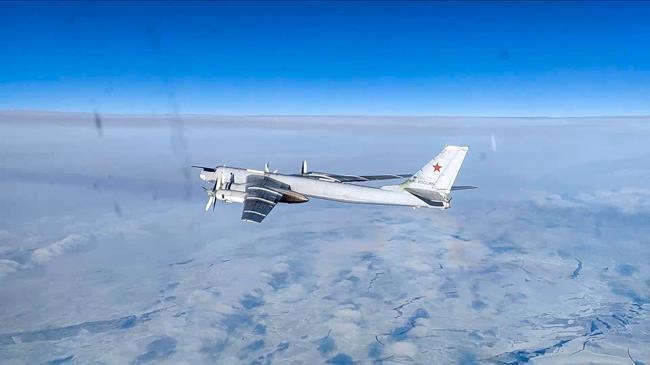OTTAWA — After days of shooting down unidentified “objects,” fighter jets from Canada and the United States were scrambled Monday night to intercept four Russian military aircraft as they buzzed North American airspace.
The North American Aerospace Defence Command, which detected the group comprised of Russian long-range bombers and fighter escorts as it approached Alaska, painted the incident as a normal occurrence that did not pose any threat.
Norad also dismissed the Russian flight as unrelated to the string of suspected balloons shot down in the skies over North America, even as the search for wreckage from those objects continued in central Yukon and Lake Huron on Tuesday.
Air-traffic watchers were first alerted to another potential incident late Monday when they noticed a Canadian Armed Forces refuelling aircraft heading northwest from Cold Lake, Alta., using a call sign associated with airborne intercepts.
The CC-150 Polaris refuelling aircraft, whose flight path from Cold Lake can be tracked on open-source websites, returned home in the pre-dawn hours of Tuesday morning. The Air Force said CF-18s were also deployed alongside American aircraft.
In a statement released hours later, Norad revealed that it had intercepted a group of Russian aircraft comprised of Tu-95 long-range bombers and Su-35 fighter aircraft as they approached Alaskan airspace.
“Russian aircraft remained in international airspace and did not enter American or Canadian sovereign airspace,” Norad said. “This Russian activity … is not seen as a threat, nor is the activity seen as provocative.”
The appearance of Russian military aircraft near Alaska comes after an American fighter jet shot down what officials have described as an “object,” but which increasingly appears to have been a balloon, off the state’s northeastern coast on Friday.
A second “object” was destroyed over central Yukon on Saturday, and a third over Lake Huron on Sunday. Officials have said little about these objects, though Prime Minister Justin Trudeau indicated on Tuesday that they are balloons.
“What we're seeing is there's a range of different balloons that seem to be in different sizes and different numbers,” he told reporters before meeting with cabinet ministers on Parliament Hill.
“We are now continuing to do all the search we can to try and find and recover these items so that we know more about them. What is very clear is they were a threat to civilian travel, to commercial airliners.”
In its statement, Norad ruled out any direct connection between these suspected balloons and the deployment of Russian bombers toward North America, which Moscow has done sporadically since 2007.
“Norad also assesses that this Russian flight activity is in no way related to recent Norad and U.S. Northern Command operations associated with airborne objects over North America during the last two weeks,” it said.
Norad did not say whether there have been other Russian long-range bomber flights this year, or how many there were last year.
Meanwhile, as the Canadian and American militaries continued scouring the sky for more potential threats, efforts to recover the wreckage of the objects downed in Yukon and Lake Huron were making little headway.
In an update outside the House of Commons, Public Safety Minister Marco Mendicino and Fisheries Minister Joyce Murray, who is responsible for the Canadian Coast Guard, said the wreckage had yet to be recovered.
"It is important to highlight that the stretches of land in the Yukon where operations are being conducted are very remote, difficult to access, and especially given the current conditions,” Mendicino said.
“Given the fact that there's a lot of snow, a lot of wind, et cetera, you will appreciate that this is going to take some time.”
Officials were also still trying to pinpoint where the object went down in Lake Huron. An American jet fighter destroyed it with a second missile after its first missed on Sunday, the U.S. military’s top commander, Gen. Mark Milley, told reporters in Brussels.
Mendicino would not speculate on how long the two searches, which are being conducted at the same time as American officials are scouring seas off the coast of Alaska for the third object, would continue.
“It's important to defer to the experts in the field, so the Armed Forces, the RCMP and the Coast Guard will be best situated to provide answers to those questions,” he said.
“I'll just say that I know there's a lot of ongoing curiosity to get to the bottom of what all of this is. I appreciate that. And that's why yesterday we provided a briefing from those agencies, and we'll continue to look to them to answer those questions.”
This report by The Canadian Press was first published Feb. 14, 2023.
Lee Berthiaume, The Canadian Press



